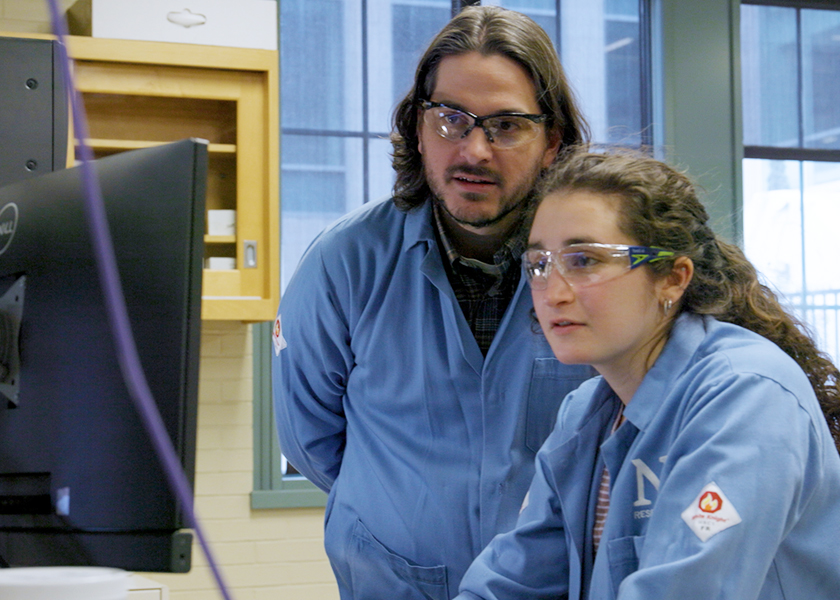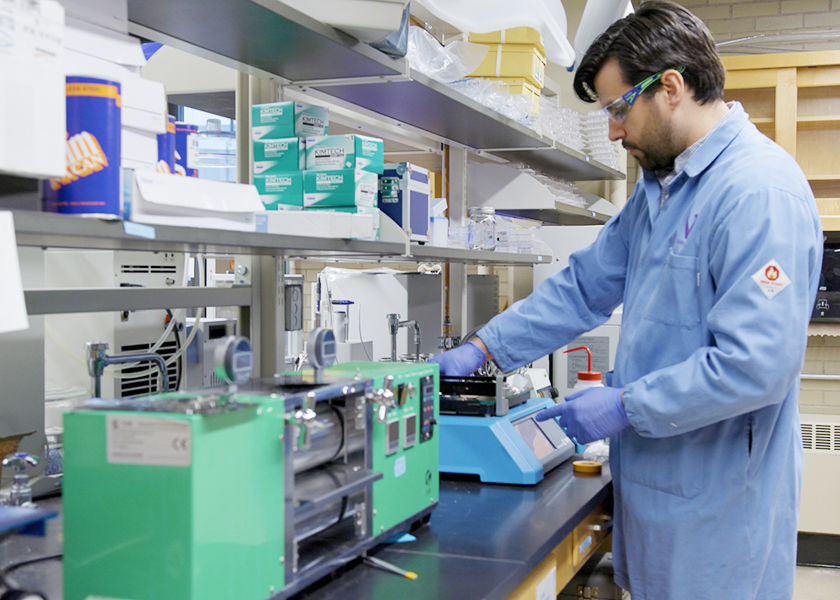A Faster Way to Innovate Materials
Jeffrey Richards and Jeffrey Lopez are making manufacturing and battery design more sustainable
To help his students conceptualize the method of concurrent materials design, one of 10 priority research areas outlined in Northwestern Engineering’s new strategic vision, the McCormick School of Engineering’s Jeffrey Richards told them to think about making bread.
“If you take yeast, flour, water, and salt and mix them together, you won’t necessarily make good bread,” said Richards, assistant professor of chemical and biological engineering, who studies the properties of soft materials used in renewable technologies. “You must consider more than just the ingredients, like how long you let the dough rise, how you kneaded it, and the temperature at which it was baked. It’s only by considering all the elements of the raw ingredients and how they get transformed into bread that you can make a product that tastes good.”
Likewise, engineers using concurrent materials design look at product development holistically, sifting through or designing processes and materials to create products with pre-selected desirable traits. Think high-capacity, low-cost batteries made of materials that are both sustainable and easy-to-recycle or quantum computers with efficient energy transfer, reliable qubits, and the ability to operate without complex and costly cooling systems.
“Concurrent materials design uses what we know about a material and a process to predict outcomes of changes to the process or material. It also allows us to design new products or processes that can give rise to material enhancements,” Richards said. “It’s like making a better bread through understanding all the physics that govern good bread.”

Speed and sustainability are key
Traditional engineering methods often focus on designing materials first and then adapting them to meet performance needs, or the inverse — developing products with only existing materials in mind. Concurrent materials design aims to create new materials with properties optimized for maximum performance while simultaneously designing the system or product for which they are intended to be used. This integrated approach accelerates innovation by considering multiple factors in parallel rather than sequentially.
Advances in AI and data science have allowed researchers to accelerate the process of materials design by giving them the ability to rapidly generate and analyze vast datasets to better predict material properties.
“There has been a huge increase in computational power that has allowed us to look at and answer more questions than ever before,” said Jeffrey Lopez, assistant professor of chemical and biological engineering, who studies electrochemical interfaces to design new materials for energy storage. “And because we’re able to do the work more quickly, we can actually solve harder, more complex problems on a reasonable time frame.”

Designing better batteries
That complexity in problem-solving is evident in the research being conducted by Lopez and Richards.
Lopez’s research focuses on sustainability and circularity in battery design. One project, for instance, aims to improve the performance of lithium metal anodes. Anodes made from this material can store significant energy in a small space, which could lead to lighter, longer-lasting batteries. However, lithium metal anodes react poorly with the electrolyte in batteries, causing instability. Many researchers have made progress solving this issue by adding fluorine-based chemicals to the electrolyte, but these are a type of "forever chemical" (PFAS) that don’t break down in the environment and can be harmful.
To address this, Lopez’s team is developing new electrolyte materials that work just as well —without relying on PFAS. By studying the chemical reactions that make fluorine effective, they are designing safer, fluorine-free alternatives that still protect the lithium metal and improve battery performance. Their work could help create powerful, long-lasting batteries without the environmental risks of traditional designs.
“It's critical to think holistically about the devices we're making and the materials that go into those devices, in particular around sustainability and circularity,” Lopez said. “All that gets more and more important as we make more devices and fill up landfills and see the impacts of pollution in our everyday lives. Materials design challenges us to think bigger picture about our work — to not, for example, only design the best battery, but also the most sustainable and recyclable one.”
Richards studies how battery materials change during the manufacturing process, aiming to use the data he gathers to improve predictive models and speed up battery design using AI. He currently leads a US Department of Energy-funded project that uses neutron scattering — a powerful technique that requires a nuclear reactor — to peer inside the electrodes of lithium-ion batteries at the nanoscale to observe physical and chemical changes during manufacturing and operation.
This research is challenging without neutron scattering because traditional imaging methods struggle to penetrate dense battery materials without damaging them. The properties of neutrons, however, allow them to pass through these materials without causing structural damage, making them ideal for revealing critical changes during battery operation. By better understanding how and why batteries fail, this research will help scientists develop a more accurate materials design framework for enhancing battery performance and lifespan.
“As engineers, we’re looking to minimize the impact of our products and manufacturing processes on the environment and human health,” Richards said. “With concurrent materials design, we can optimize for sustainability more quickly than traditional approaches.”